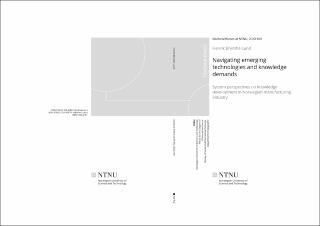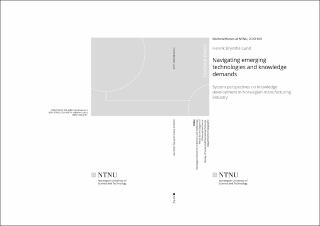| dc.contributor.author | Lund, Henrik Brynthe | |
| dc.date.accessioned | 2020-05-15T07:21:32Z | |
| dc.date.available | 2020-05-15T07:21:32Z | |
| dc.date.issued | 2020 | |
| dc.identifier.isbn | 978-82-326-4687-6 | |
| dc.identifier.issn | 1503-8181 | |
| dc.identifier.uri | https://hdl.handle.net/11250/2654548 | |
| dc.description.abstract | This thesis explores the development of technology and knowledge capabilities in Norwegian manufacturing industry, with an emphasis on two manufacturing clusters and their surrounding regions. Recent technological developments related to the concept Industry 4.0 has put technological and knowledge upgrading on the political agenda and has created a momentum for manufacturers to upgrade their capabilities. These upgrading processes demand close collaboration between firm and non-firm actors. As such, the thesis explores how non-firm actors such as national and regional institutions and organizations engage with manufacturers to develop firm capabilities and how these interactions lead to regional economic development. In its analysis, inspired by the pluralistic approach to theory within economic geography, the thesis employs three theoretical approaches from the field of economic geography; the cluster approach, the regional innovation system approach, and the global production network framework. The thesis finds that employing these system approaches to understand upgrading processes and related regional economic development provides a holistic understanding of the multi-scalar processes of technology and knowledge upgrading, which involves firm and nonfarm actors from local, regional, national and international levels.
The main aim of the thesis is to provide insights on how firm and non-firm actors in a high cost country (Norway) are engaging in processes of technology and knowledge upgrading in face of rapid technological advances within the manufacturing industry. In addition to study ongoing processes within Norwegian manufacturing industry and their impact on regional economic development, the thesis studies how existing, historically developed regional capabilities have been developed in the post-war period (1945–2019), providing vital background knowledge for understanding recent developments. In so doing, the thesis aims to contribute to theorizing within economic geography by exploring and developing existing system approaches.
The thesis consists of two parts. The first part consists of five chapters that outlines the thesis’ empirical and theoretical background, describes the overall research design and methodology, and the overall contributions and suggests directions for future research. The second part consists of four individual research articles that addresses three different themes. The first theme concerns cluster dynamics and evolution and is covered by the articles On the evolution of clusters and the role of state agency: An historical analysis of two defence-related high-tech clusters in Norway and Cluster absorptive capacity: the roles of intermediaries in technology upgrading of manufacturing clusters. The former longitudinal study analyses the role of the Norwegian state in developing the two Norwegian manufacturing clusters Kongsberg and Raufoss from state owned companies into clusters with distinct knowledge bases, while the latter explores how cluster intermediaries develop the two clusters’ absorptive capacities as they facilitate the absorption of extra-local knowledge and spreading it to cluster firms. The second theme relates to the evolution of regional innovation systems. The article The Importance of Vocational Education Institutions in Manufacturing Regions: Adding Content to a Broad Definition of Regional Innovation Systems studies how vocational education institutions in manufacturing regions are key knowledge providers and how regional innovation systems are changing due to the co-evolution of technology, industry and education. The third theme relates to the broader discussion on the spatial division of labour, and, more explicitly, the reshoring of manufacturing activities. The article Make at home or abroad? Manufacturing reshoring through a GPN lens: a Norwegian case study studies how advanced manufacturing technologies act as a driver for manufacturing reshoring when matched with key regional assets such as knowledge and competence, organizational culture, key human capital and region-specific manufacturing competence. | en_US |
| dc.language.iso | eng | en_US |
| dc.publisher | NTNU | en_US |
| dc.relation.ispartofseries | Doctoral theses at NTNU;2020:169 | |
| dc.relation.haspart | Paper 1: Steen, M., Lund, H. B and Karlsen, A. (2019). On the evolution of clusters and the role of state agency: An historical analysis of two defence-related high-tech clusters in Norway | en_US |
| dc.relation.haspart | Paper 2: Karlsen, A., Lund, H. B and Steen, M. (2019). Cluster absorptive capacity: the roles of intermediaries in technology upgrading of manufacturing clusters.
PEGIS.2019/17 | en_US |
| dc.relation.haspart | Paper 3: Lund, H. B. and Karlsen, A. (2019). The Importance of Vocational Education Institutions in Manufacturing Regions: Adding Content to a Broad Definition of Regional Innovation Systems. Industry and Innovation: 1-20 http://doi.org.10.1080/13662716.2019.1616534 | en_US |
| dc.relation.haspart | Paper 4:
Lund, H.B. and Steen, M.
Make at home or abroad? Manufacturing reshoring through a GPN lens: a Norwegian case study
- The final published version is available in
Geoforum
https://doi.org/10.1016/j.geoforum.2020.04.015
Under a Creative Commons license (CC BY 4.0) | en_US |
| dc.title | Navigating emerging technologies and knowledge demands System perspectives on knowledge development in Norwegian manufacturing industry | en_US |
| dc.type | Doctoral thesis | en_US |
| dc.subject.nsi | VDP::Social science: 200::Human geography: 290 | en_US |

